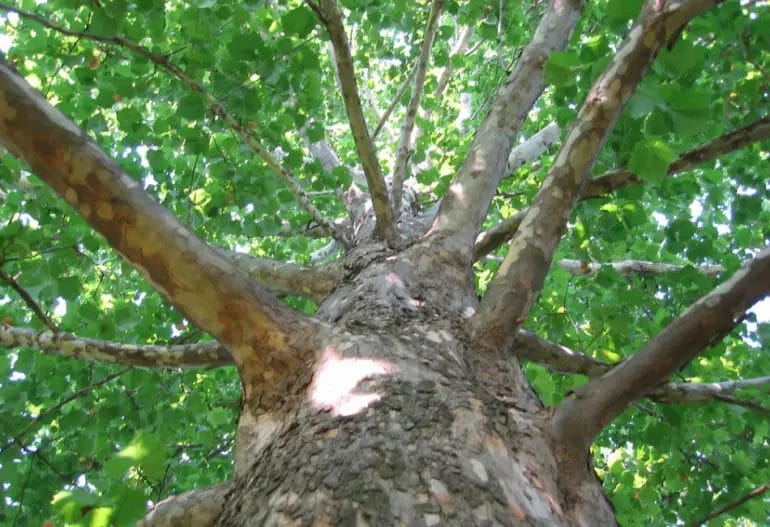Sycamore wood, known for its distinctive grain and beautiful color, is highly versatile and has various applications in both construction and woodworking.
Due to its durability and strength, sycamore wood is often used for making furniture, cabinets, and flooring, adding a touch of elegance to any space.

Additionally, sycamore wood’s fine texture makes it a popular choice for carving and turning, allowing artisans to create intricate designs and decorative pieces.
Its natural resistance to decay and insect damage also makes sycamore wood suitable for outdoor projects like decks, fences, and pergolas.
Whether you’re looking for a sturdy building material or an exquisite piece of craftsmanship, sycamore wood offers a range of possibilities.

Advantages of Sycamore Wood: Why it Stands Out for Various Purposes
Sycamore wood, also known as plane tree wood, is a versatile and highly sought-after material for a variety of purposes. Its unique characteristics and properties make it stand out among other types of wood. In this section, we will explore the advantages of using sycamore wood and why it is favored for different applications.
Durability and Strength
Sycamore wood is known for its exceptional durability and strength. It is a dense hardwood that is resistant to wear and tear, making it highly suitable for both indoor and outdoor applications. Whether it is used for furniture, flooring, or outdoor structures, sycamore wood offers long-lasting performance, withstanding heavy use and exposure to various elements.
Beautiful Aesthetic Appeal
One of the most notable advantages of sycamore wood is its natural beauty. It has a distinct grain pattern with unique markings, ranging from light creams to warm browns, which adds character and visual appeal to any project. Sycamore wood is often sought after for its aesthetic qualities in furniture making, cabinetry, and decorative items.
Easy to Work With
Sycamore wood is highly regarded by craftsmen and woodworkers for its ease of workability. It has excellent machining properties, allowing it to be easily cut, shaped, and carved. This makes it a preferred choice for intricate woodworking projects where precision and attention to detail are essential.
Good Stability
Another advantage of sycamore wood is its stability. It has low shrinkage and minimal movement when exposed to changes in humidity and temperature. This stability makes it an ideal choice for applications such as flooring, where the wood needs to withstand varying environmental conditions without warping or buckling.
Versatility
Sycamore wood is highly versatile and can be used for a wide range of applications. From furniture making to veneer production, musical instruments to kitchen utensils, sycamore wood’s versatility knows no bounds. Its durability, attractive appearance, and easy workability make it a preferred choice for both functional and decorative purposes.
Environmentally Friendly
Choosing sycamore wood is also an environmentally friendly choice. Sycamore trees are abundant in many regions, and the wood is typically sourced from sustainably managed forests. By opting for sycamore wood, you can support responsible forestry practices and contribute to the preservation of our natural resources.
In summary, sycamore wood offers numerous advantages that set it apart for various purposes. Its durability, aesthetic appeal, workability, stability, versatility, and environmental friendliness make it a favored choice among craftsmen, woodworkers, and individuals seeking high-quality wood materials. Whether you’re looking to create stunning furniture, durable flooring, or unique decorative items, sycamore wood is a reliable and exceptional option.

Sycamore Wood in Furniture Making: Creating Stunning and Durable Pieces
Sycamore wood, known for its beautiful grain and durability, has long been a favorite among furniture makers. With its unique characteristics and versatility, it offers a wide range of possibilities for creating stunning and durable pieces of furniture. In this section, we will explore the various aspects of using sycamore wood in furniture making and how it can elevate the quality and aesthetics of your creations.
1. The Beauty of Sycamore Wood
Sycamore wood is renowned for its natural beauty and distinctive grain patterns. It has a pale, creamy color with subtle variations, ranging from light brown to pinkish tones. The grain of sycamore wood is straight and fine, which adds elegance and sophistication to any furniture piece.
One of the unique features of sycamore wood is its ability to display a phenomenon called “figuring.” This phenomenon produces a wavy, quilted, or “blistered” appearance on the surface of the wood, enhancing its visual appeal. Furniture made from figured sycamore wood can truly stand out as a focal point in any room.
2. Durability and Longevity
When it comes to furniture making, durability is a crucial factor. Sycamore wood is highly regarded for its strength and resistance to wear and tear. It is a dense hardwood that can withstand the test of time, making it an excellent choice for furniture that needs to endure regular use.
In addition to its natural durability, sycamore wood is also resistant to warping and splitting, which are common concerns in furniture construction. This makes it highly suitable for crafting long-lasting pieces that can be passed down through generations.
3. Versatility in Design
Sycamore wood offers exceptional flexibility in design. Its neutral color and attractive grain pattern make it a versatile choice for both traditional and contemporary furniture styles. Whether you prefer a rustic farmhouse look or a sleek modern design, sycamore wood can adapt to your vision.
Furthermore, sycamore wood can be easily stained or finished to achieve the desired color or tone. Its smooth texture allows for flawless finishes, enhancing the overall aesthetic appeal of the furniture piece. From light natural finishes to dark stains, sycamore wood can be transformed to complement any interior design scheme.
4. Sustainability and Environmental Considerations
As the demand for sustainable and eco-friendly materials grows, sycamore wood stands out as a responsible choice for furniture making. Sycamore trees are abundant and widely available, making them a renewable resource. Harvesting sycamore wood does not contribute to deforestation, making it an environmentally conscious option.
Furthermore, sycamore wood can be sourced locally, reducing the carbon footprint associated with transportation. Choosing sycamore wood for your furniture projects not only showcases your commitment to sustainability but also supports local economies.
5. Care and Maintenance
To ensure the longevity of your sycamore wood furniture, proper care and maintenance are essential. Regular dusting and light cleaning with a damp cloth can help maintain its natural beauty. Avoid using abrasive cleaners or harsh chemicals that can damage the wood’s finish.
Periodically applying a high-quality furniture polish or wax can help protect the wood and enhance its luster. This will also help preserve the unique grain patterns of sycamore wood, keeping your furniture looking stunning for years to come.
Summary
Sycamore wood is a remarkable choice for furniture making, thanks to its inherent beauty, durability, and versatility. Its unique grain patterns and figure make each piece of furniture truly one-of-a-kind. Whether you are a professional furniture maker or a homeowner looking for high-quality pieces, incorporating sycamore wood into your designs will result in stunning and enduring furniture that will stand the test of time.

Sycamore Wood for DIY Projects: Unleash Your Creativity with this Remarkable Material
When it comes to DIY projects and crafting, finding the right material is essential. Sycamore wood is a remarkable choice that can truly unleash your creativity and help you create stunning pieces. In this section, we will explore the unique qualities of sycamore wood and why it is an excellent option for your next DIY project.
The Beauty of Sycamore Wood
Sycamore wood is known for its exceptional beauty and versatility. It is a hardwood with a distinct light cream to white color, often featuring delicate streaks of brown or gray. This natural color variation adds character and uniqueness to any project.
Furthermore, sycamore wood has a fine and even texture, making it easy to work with. It is relatively lightweight compared to other hardwoods, making it ideal for various projects, including furniture, cabinetry, and decorative items.
Durability and Strength
One of the key reasons why sycamore wood is favored by DIY enthusiasts is its durability and strength. Despite its lightweight nature, sycamore wood is remarkably sturdy and can withstand the test of time. This makes it an excellent choice for projects that require durability, such as outdoor furniture or flooring.
Additionally, sycamore wood has good shock resistance, making it less prone to denting or scratching. This makes it suitable for high-traffic areas or items that may experience frequent use.
Easy to Work With
Sycamore wood is a joy to work with due to its excellent workability. It can be easily cut, shaped, and joined, making it ideal for both beginner and experienced DIYers. The wood holds nails and screws well, ensuring a secure and long-lasting construction.
Furthermore, sycamore wood responds well to various finishes, such as staining, painting, or simply applying a clear coat to enhance its natural beauty. This versatility allows you to customize your projects according to your desired aesthetic.
Environmentally Friendly Choice
Choosing sycamore wood for your DIY projects is also an environmentally friendly choice. Sycamore trees are fast-growing and abundant, making them a sustainable source of wood. By opting for sycamore wood, you are contributing to the preservation of our forests and reducing the demand for less sustainable alternatives.
In summary, sycamore wood is an excellent choice for DIY projects due to its exceptional beauty, durability, workability, and environmental benefits. Whether you are creating furniture, decorative items, or anything in between, sycamore wood will allow you to unleash your creativity and bring your ideas to life. Embrace the versatility and natural elegance of sycamore wood and let your DIY projects shine.
Sycamore Wood in Construction: Discover its Strength and Durability for Building Projects
When it comes to construction materials, wood has been a popular choice for centuries. Its natural beauty, versatility, and eco-friendliness make it ideal for various applications in building projects. One type of wood that is gaining attention in the construction industry is Sycamore wood. In this section, we will explore the strength and durability of Sycamore wood and why it is an excellent choice for construction projects.
1. Overview of Sycamore Wood
Sycamore wood, scientifically known as Platanus occidentalis, is a hardwood species that is native to North America. It is commonly found in the eastern and central regions of the United States. Sycamore wood is known for its distinct creamy-white to light brown color, with interlocking grains that give it a unique appearance.
2. Strength and Stability
One of the key reasons why Sycamore wood is highly regarded in construction is its strength and stability. It has a high density and is classified as a hardwood, which means it is more resistant to wear and tear compared to softwoods. Sycamore wood has excellent bending and crushing strength, making it suitable for load-bearing structures and heavy-duty applications.
Moreover, Sycamore wood is known for its stability, meaning it has a low tendency to warp, twist, or shrink. This characteristic makes it an ideal choice for flooring, furniture, and other applications that require dimensional stability.
3. Durability and Resistance
Sycamore wood possesses natural durability and resistance to decay. It is moderately resistant to rot and can withstand exposure to the elements, making it suitable for both interior and exterior applications. However, it is recommended to apply a protective finish to enhance its longevity and further protect it from moisture and insect infestation.
4. Workability and Versatility
Sycamore wood is highly workable, making it a favorite among carpenters and woodworkers. It is easy to cut, shape, and join, which allows for intricate detailing and precision in construction projects. Additionally, Sycamore wood has good gluing and finishing properties, making it suitable for various finishes and coatings.
Furthermore, Sycamore wood is versatile and can be used in a wide range of applications. It is commonly utilized in furniture making, cabinetry, flooring, millwork, and even musical instruments. Its aesthetic appeal and durability make it a sought-after material for both residential and commercial projects.
5. Environmental Considerations
Choosing Sycamore wood for construction projects also has environmental benefits. Sycamore trees are fast-growing and have a high regeneration rate, making them a sustainable choice for timber production. By using Sycamore wood, builders can contribute to the preservation of forests and reduce the ecological impact associated with other construction materials.
Summary
Sycamore wood is a strong, durable, and versatile material that is well-suited for construction projects. Its strength and stability make it ideal for load-bearing structures, while its durability and resistance to decay ensure its longevity. In addition, Sycamore wood’s workability and aesthetic appeal make it a popular choice for various applications.
Considering its environmental benefits, such as its sustainable sourcing and low ecological impact, Sycamore wood is an excellent option for builders who prioritize both quality and sustainability. Whether it’s for flooring, furniture, or other construction projects, Sycamore wood offers the strength, durability, and natural beauty that construction professionals seek.
FAQs
Is sycamore wood good for anything?
Yes, sycamore wood is versatile and commonly used in furniture making, cabinetry, flooring, and musical instruments. It has a beautiful grain pattern and is known for its durability and strength. Additionally, sycamore wood is often used for decorative purposes such as veneers or turned objects.
Conclusion
In conclusion, sycamore wood is a versatile and valuable material with numerous applications. Its durability, strength, and attractive grain make it suitable for various woodworking projects. Whether used for furniture, flooring, or cabinetry, sycamore wood offers a natural beauty that enhances any space.
Additionally, its excellent workability allows for easy carving and shaping, making it a popular choice among craftsmen. Not only is sycamore wood functional, but it also has a unique aesthetic appeal, with its light color and distinctive figuring.
From decorative items to musical instruments, sycamore wood provides endless possibilities for creativity. Its availability and sustainability further contribute to its desirability. So, whether you’re an avid woodworker or simply appreciate quality craftsmanship, consider sycamore wood for your next project.